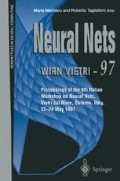Abstract
Hidden Markov models (HMMs) and input/output HMMs are probabilistic graphical models for sequence learning. When thinking in terms of data structures, a sequence can be thought of as a linear chain. Depending on the task, however, the entities that need to be adaptively processed may be organized into data structures more complex that simple linear chains. In this paper we propose a theoretical framework to extend (input/output) HMMs for processing information structured according to any directed ordered acyclic graph. The resulting hidden recursive model (HRM) can be applied to problems of data structures classification or transduction. We report experimental results for tree automata induction tasks and in a simple logical terms classification problem.
Access this chapter
Tax calculation will be finalised at checkout
Purchases are for personal use only
Preview
Unable to display preview. Download preview PDF.
References
Bengio, Y., and Frasconi, P. (1996). Input-output HMM’s for sequence processing. IEEE Transactions on Neural Networks, 7 (5), 1231–1249.
Jensen, F., Lauritzen, S., and Olesen, K. (1990). Bayesian updating in recursive graphical models by local computations. Computational Statistical Quarterly, 4, 269–282.
Omlin, C., and Giles, C. (1996). Constructing deterministic finite-state automata in recurrent neural networks. Journal of the ACM, 5 (6), 937–972.
Pearl, J. (1988). Probabilistic Reasoning in Intelligent Systems: Networks of Plausible Inference. Morgan Kaufmann.
Rabiner, L. R. (1989). A tutorial on hidden Markov models and selected appli¬cations in speech recognition. Proceedings of the IEEE, 77 (2), 257–286.
Sperduti, A., and Starita, A. ((to appear)). Supervised neural networks for the classification of structures. IEEE Transactions on Neural Networks.
Thacher, J. (1973). Tree automata: An informal survey. In Aho, A. (Ed.), Currents in the Theory of Computing, pp. 1432013172. Prentice-Hall Inc., Englewood Cliffs.
Williams, R. J., k Zipser, D. (1989). A learning algorithm for continually running fully recurrent neural networks. Neural Computation, 1 (2), 270–280.
Author information
Authors and Affiliations
Editor information
Editors and Affiliations
Rights and permissions
Copyright information
© 1998 Springer-Verlag London Limited
About this paper
Cite this paper
Frasconi, P., Gori, M., Sperduti, A. (1998). Hidden Recursive Models. In: Marinaro, M., Tagliaferri, R. (eds) Neural Nets WIRN VIETRI-97. Perspectives in Neural Computing. Springer, London. https://doi.org/10.1007/978-1-4471-1520-5_32
Download citation
DOI: https://doi.org/10.1007/978-1-4471-1520-5_32
Publisher Name: Springer, London
Print ISBN: 978-1-4471-1522-9
Online ISBN: 978-1-4471-1520-5
eBook Packages: Springer Book Archive

